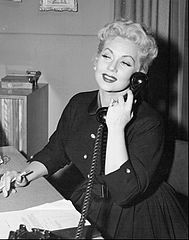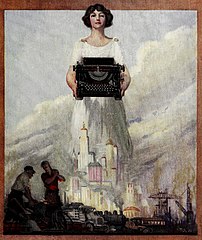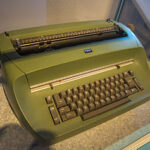
In 1957, Time Magazine observed a national shortage of secretaries.
With over 21 million women in the workforce, only 2 million were employed as secretaries which meant that every day there were 250,000 unfilled secretarial positions. To make matters worse, employers were caught in a dilemma. Women over age 35 were considered to set in their ways to adjust to a new boss or position, while younger women lacked experience.
Employers wanted a secretary who could either take dictation as needed, or write the letter herself. She should be able to type, answer the phone, handle incoming and outgoing mail, make appointments, and file. She should handle light bookkeeping, make restaurant reservations, and take conference minutes. Often, she made the coffee, picked up the boss’s dry cleaning, and purchased gifts on his behalf. It was all part of making the office run smoothly. Ideally, the secretary accomplished all these activities with a smile. Secretarial positions were often referred to as “pink collar” jobs. In 1957 a secretary earned $3,375/annually at a time when beer cost between 9 and 25 cents per bottle.
Incidentally, while doing these vital but uncomplicated tasks, the secretary should look well-groomed and glamorous like this picture of Ann Sothern in the 1954 sitcom Private Secretary.
When did the secretarial position begin?

Historically, clerks and secretaries have been around a long time, but I think the office position we think of began with typing. Christopher Latham Sholes invented the mechanical typing machine during the 1860s. E. Remington and Sons recognized the machines had potential and manufactured them as part of their sewing machine division. Originally, the keys were arranged in two rows in alphabetical order, but in 1875 Sholes introduced the QWERTY keyboard that is still with us today. Some say Sholes came up with the new keyboard design to prevent the keys from jamming by forcing operators to slow down their key strikes. Another, and possibly more plausible, explanation is that the new design was easier for telegraph operators who had to translate Morse code.
The first typewriter operators were male. However, men could find more appealing jobs in manufacturing, mining, and construction fields. During the 1880s as office work grew, companies began to hire women as typists and stenographers. Women were less expensive and more available. An 1885 article in Manufacturer and Building indicated New York City employers paid female typists $12-$15 per week. Moreover, as John Harrison wrote in the 1888 Manual of the Typewriter, “The typewriter is especially adapted to feminine fingers. They seem to be made for typewriting. The typewriting involves no hard labor and no more skill than playing the piano.” By the 1930s, secretarial work belonged to women.
The Office Revolution

Offices and office equipment changed dramatically in the post-war years. In 1959, Xerox introduced an office copier using a technology the company called xerography. Quickly carbon copies, and even mimeographs, became unnecessary. In 1961 IBM introduced the Selectric electric typewriter. With immediate effect, the fastest typist could input 90 words per minute compared to 50 wpm on a manual machine. My first job in college was using a large Xerox machine to make copies for library patrons. I think the charge was 10 cents a page. After college, I graduated to the green IBM Selectric typewriter,🎉 though I’m not convinced I needed a degree to type. However, the combination of a Selectric typewriter and a college degree does point to the fact that secretarial staff were becoming more educated.
Improved technology required staff that could efficiently operate the new expensive machines. In 1972 Olivetti introduced its model 94c that could justify text borders and featured lift-off corrections. Olivetti’s advertising campaign, directed at the secretarial staff, stressed the machine’s ability to make secretaries look better – and more hip – than they ever had before. Out with the matronly office manager with her hair in a bun. In with less experienced young women who knew how the new machines worked. Kind of makes me wonder if senior office staff countered the advertising with an emphasis on keeping costs down. I worked in an office where the only person with one of these magic machines was the office manager, and she had no intention of sharing the technology.

Smart typewriters were soon obsolete with the advent of personal computers, and software programs. The boss could now write his or her own letters and send them directly to the printer. He or she could even [gasp] make appointments on a joint software calendar. The position of secretary became redundant in favor of Administrative Professionals and Personal Assistants.
Today, employers need people to run the office, respond to questions and emergencies, take care of travel arrangements, maintain websites, and organize conferences, among many other tasks. According to Melba A. Duncan writing in the Harvard Business Review, a senior executive with a compensation package worth $1 million annually works with an assistant earning $80,000 who enables an 8 percent increase in executive productivity.
This is Administrative Professionals Week
In an effort to recognize the contributions and skills secretaries brought to the workplace, the National Secretaries Association formed in 1942. Ten years later, the U. S. Secretary of Commerce declared National Secretaries Week. The name changed to Administrative Professionals Week in 2000.
Without a doubt, from your doctor’s office to most places of business, there is an Administrative Professional who makes your life more efficient. [If you run your own business, that person could be you.] Take a moment this week to thank the people who keep communications and papers running smoothly.
⌨️ ⌨️ ⌨️
Illustrations
Ann Sothern as Susie McNamara from television program Private Secretary.
Allegorical Image of Typewriter. 1923.
IBM Selectric Typewriter by Maksym Kozlenko.
Two Women on Early Computer. 1983. By Deutsche Fotothek.
“The Secretary Shortage.” Time Magazine. April 8, 1957.
Ann Eagle. “A Job Once Filled by Men.” Chicago Tribune. April 26, 2006.
Melba J. Duncan. “The Case for Executive Assistants.” Harvard Business Review. May 2011.
United States Bureau of the Census. P-19 Currant Population Reports. Series P-60, Consumer Income. 1957.

Sandra Wagner-Wright holds the doctoral degree in history and taught women’s and global history at the University of Hawai`i. Sandra travels for her research, most recently to Salem, Massachusetts, the setting of her new Salem Stories series. She also enjoys traveling for new experiences. Recent trips include Antarctica and a river cruise on the Rhine from Amsterdam to Basel.
Sandra particularly likes writing about strong women who make a difference. She lives in Hilo, Hawai`i with her family and writes a blog relating to history, travel, and the idiosyncrasies of life.

